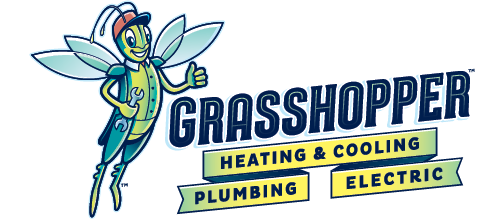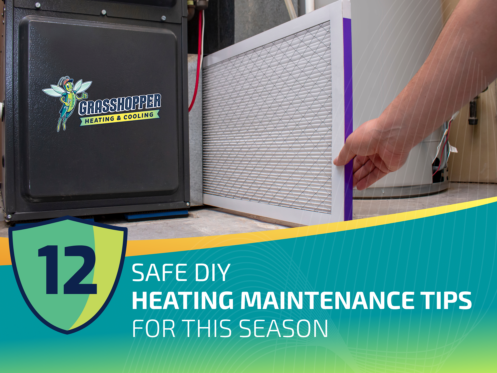There are many DIY heating maintenance steps you can take in addition to scheduling an annual furnace tune-up. The combination of professional check-ups and general upkeep throughout the year will increase your furnace’s performance and efficiency. Here are 12 DIY tips to help your heater remain in peak condition:
1. Properly Clean the Air Filter
Disposable filters should be replaced at least every three months. When you check the filter, look for dust or if the media is covered in a dark gray or black material. High-efficiency particulate air (HEPA) filters can last six months; some high-end ones can remain efficient for up to a year. Regardless of the filter you have, not cleaning or changing it will reduce airflow, make it hard for your furnace to provide heat, and impact indoor air quality.
2. Install the Right Filter
Check with your local heating maintenance contractor, a hardware store, or the user manual to determine the right filter to use. Depending on the furnace model, the filter size and type can vary. Installing the wrong one can damage your furnace and HVAC system.
3. Clean the Inside of the Furnace
Cleaning inside the unit is simple. Remove the cover and use a vacuum cleaner with a hose attachment to clean loose dust, dirt, and debris from the base. Also, use the vacuum to clean crevices, gas burners, and the tops of ducts, pipes, and conduits leading into the unit. Vacuum the floor surrounding the furnace as well. If especially handy, attach a ½-inch drain line to the vacuum hose to clean out the burner and blower cavities.
4. Check that the Burner Flames Are Blue
With the cover open, turn on the furnace and raise the temperature on the thermostat. The burner flames should be blue. If they’re yellow or any other color, there’s a combustion problem and you should call for help right away.
5. Clean the Flame Sensor
The flame sensor should slide out easily from its bracket. If it’s coated in residue, the furnace may not ignite. Use a fine emery cloth to clean the residue off gently. Then slide the flame sensor back into place.
6. Blow Dust/Dirt off the Pilot
A drinking straw doubles as a handy tool. Direct it at the pilot and blow into it to remove dust from the area. If the pilot is dirty, a flame sensor or thermocouple can falsely read that it isn’t lighting.
7. Dust the Hot Surface Ignitor
If you have a newer furnace with a hot surface ignitor, carefully detach the ignitor element and hold it by the base, or depending on the model, leave the ignitor in place. Touching the metal or the spark wires can leave behind skin oil that can damage the part. Use a scuff pad to gently clean the metal surface.
8. Check for Drive Belt Wear
If your furnace has a belt-driven blower, the belt may occasionally need to be adjusted or replaced. When inspecting the belt, check if it’s cracked or frayed. You can try tensioning a loose belt if you know how, but it’s best to let a professional make any adjustments or repairs.
9. Declutter the Area Around Your Heater
Don’t store boxes, containers, tools, or toys around the furnace. Clutter can cause the unit to run inefficiently and make it hard to access. This may not sound like furnace maintenance, but it can go a long way in helping the system work better.
10. Vacuum Air Registers and Return Vents
Removing dust from registers and vents is an effective way to help your furnace run smoothly. Any type of blockage can restrict airflow and cause all kinds of trouble. Also, make sure no furniture, storage cabinets, or toys are covering these openings.
11. Adjust the Dampers
The ductwork serving both your heating and cooling system may have dampers that need seasonal adjustments. The markers on dampers or duct walls will show you how to adjust them. Moving the damper handle on the supply trunk enables the system to deliver more warm air downstairs in winter or more cold air upstairs in summer.
12. Replace Thermostat/Carbon Monoxide Detector Batteries
If your thermostat is battery-operated, change the batteries at least once a year or if the unit doesn’t respond to commands or the screen doesn’t light. A malfunctioning thermostat can cause your heating system to be ineffective. Also, remember to change your carbon monoxide detector batteries. This safety feature doesn’t improve furnace performance but will alert you if toxic gas is present and there’s a potential furnace problem.
Contact Grasshopper for Heating Maintenance
Grasshopper Heating & Cooling provides professional furnace tune-ups in Clifton Park, NY, and surrounding areas. Filter replacement, coil and burner cleaning, electrical wiring checks, thermostat calibration, and an air pressure and start-up check are included in our maintenance program. The preventative measures our NATE-certified technicians take can protect your home and help your furnace last longer. Call (518) 254-8263 to schedule service.












